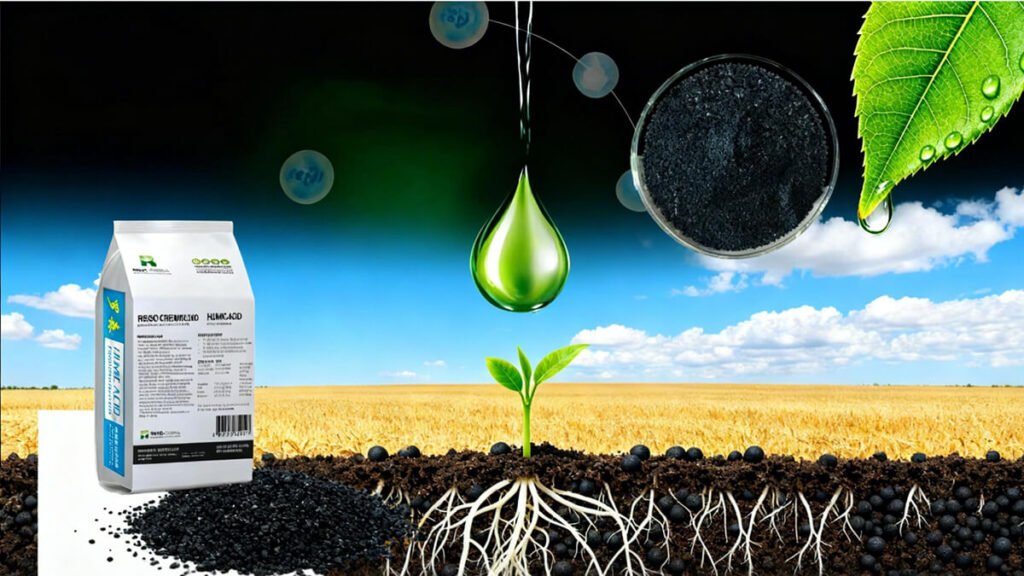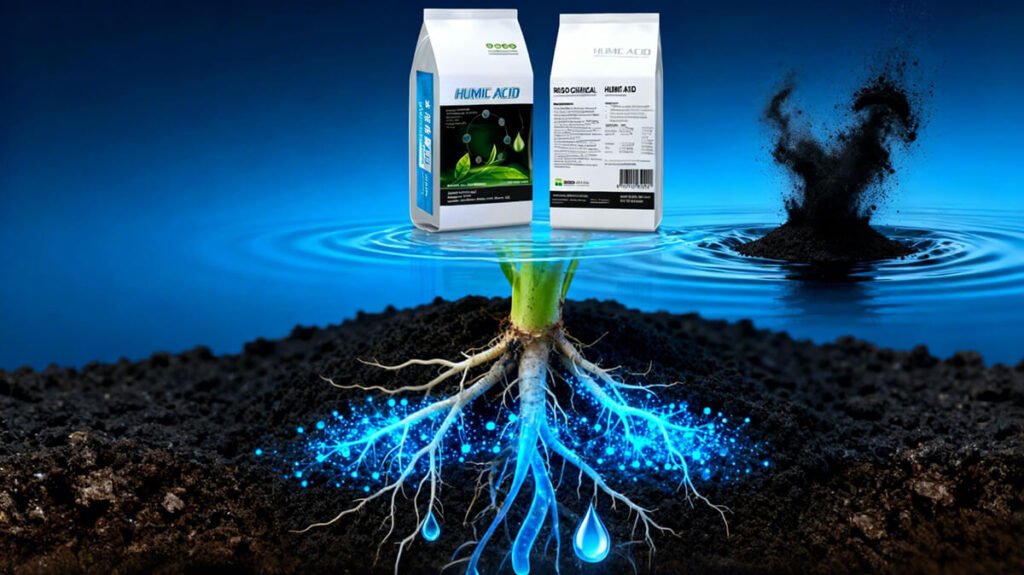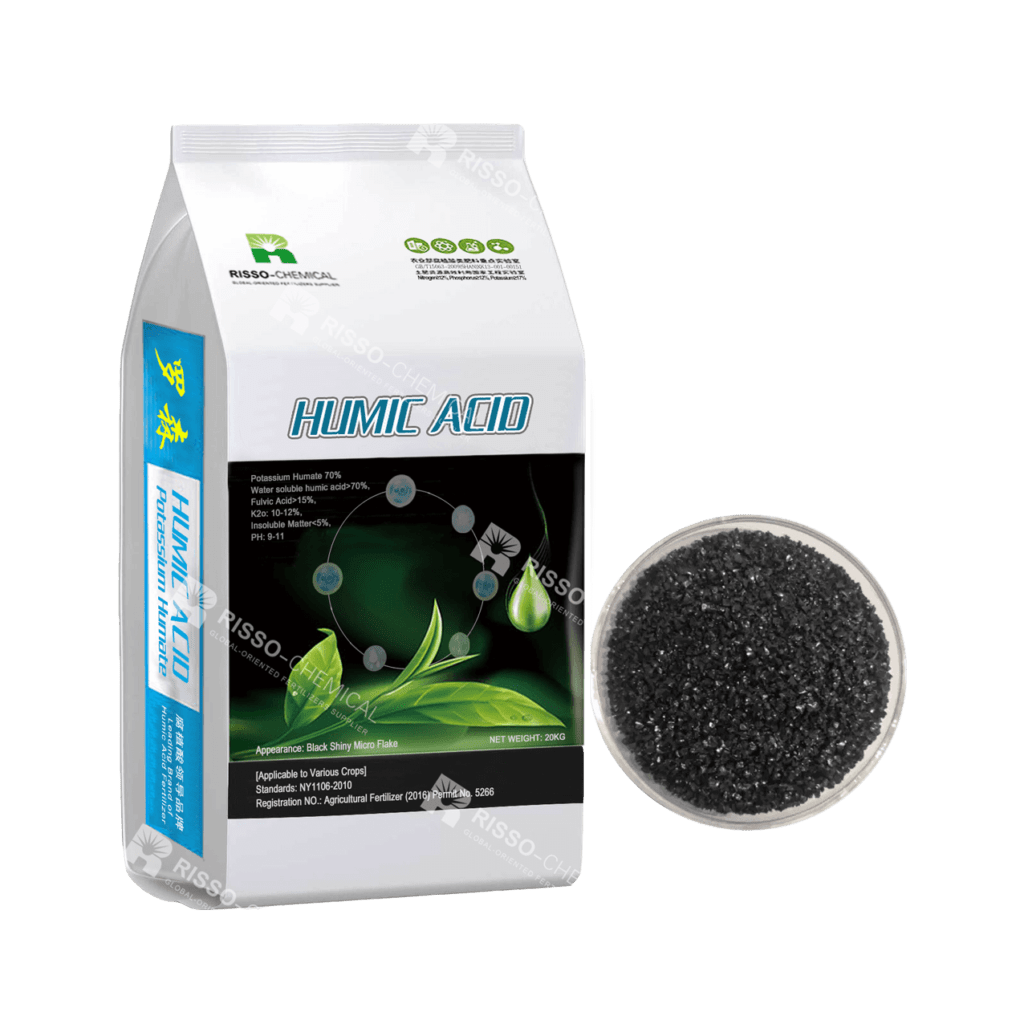Let more growers get greater benefits
How Potassium Humate Boosts Fertilizer Efficiency & Growth?
- Industry News
- November 21, 2025
- 2:40 pm
Potassium humate (K-humate) is a highly soluble humic substance enriched with humic and fulvic acids. It improves fertilizer efficiency and plant growth by increasing nutrient retention in soils, enhancing root development and membrane permeability, stimulating beneficial soil microbes, and promoting physiological processes such as photosynthesis and nutrient assimilation. When applied correctly—via seed treatment, soil drenching, fertigation, or foliar spraying—K-humate reduces fertilizer losses, improves crop resilience, and increases yields.
Risso Fertilizer offers high-quality potassium humate solutions suitable for a wide range of crops.


Table of Contents
- 1. What is potassium humate?1. What is potassium humate?
- 2. How potassium humate works — mechanisms of action2. How potassium humate works — mechanisms of action
- 3. Benefits for fertilizer efficiency and plant growth (evidence)3. Benefits for fertilizer efficiency and plant growth (evidence)
- 4. Agronomic use: application methods, timing, and rates4. Agronomic use: application methods, timing, and rates
- 5. Compatibility, quality control, and formulation tips5. Compatibility, quality control, and formulation tips
- 6. Economic & environmental considerations6. Economic & environmental considerations
- 7. Practical recommendations (grower checklist)7. Practical recommendations (grower checklist)
- 8. Selected studies & case examples8. Selected studies & case examples
- 9. Frequently Asked Questions (FAQ)9. Frequently Asked Questions (FAQ)
- 10. Conclusion10. Conclusion
1. What is potassium humate?
- Fertigation systems (drip or pivot irrigation)
- Foliar sprays for micronutrient delivery
- Seed treatments to boost germination and early root vigor
- Soil amendments for long-term soil health


2. How potassium humate works — mechanisms of action
1. Soil physicochemical improvements
- Increases cation exchange capacity (CEC)
- Enhances soil aggregation and water-holding capacity
- Reduces nutrient leaching and improves nutrient retention
2. Chelation and nutrient mobilization
- Forms complexes with micronutrients (Fe, Mn, Zn, Cu), improving availability
- Especially effective in alkaline or calcareous soils
3. Root morphology and membrane effects
- Stimulates root branching, root hair proliferation, and cell membrane permeability
- Enhances nutrient uptake efficiency and translocation
4. Biostimulant effects
- Mimics plant growth hormones (auxin-like activity)
- Promotes cell division, photosynthesis, and overall biomass accumulation
5. Microbial stimulation
- Serves as a carbon source and modulator for beneficial soil microbes
- Encourages plant growth-promoting bacteria (PGPB), improving nutrient cycling and soil health
3. Benefits for fertilizer efficiency and plant growth (evidence)
Higher nutrient uptake and reduced fertilizer needs
- Field trials demonstrate increased N, P, K, and micronutrient uptake when K-humate is combined with fertilizers
- Enables growers to reduce fertilizer rates while maintaining or increasing yields
Improved photosynthesis and yield
- Application enhances stomatal conductance, chlorophyll content (SPAD values), and photosynthetic rates
- Directly translates into improved grain and fruit yield
Enhanced stress tolerance
- Promotes drought resilience and faster recovery under abiotic stress
- Likely due to improved root architecture and soil water retention


4. Agronomic use: application methods, timing, and rates
Common application methods
- Soil application: Granular or soluble forms applied pre-plant or at planting; promotes root zone nutrient availability.
- Fertigation: Soluble K-humate mixed into irrigation water ensures even distribution.
- Foliar spray: Rapid leaf uptake; effective for early nutrient stress or growth stimulation.
- Seed treatment / priming: Low-dose soaking enhances germination and early root vigor.
Typical application rates
| Method | Recommended Range* | Notes |
|---|---|---|
| Foliar spray | 0.1–0.5% solution | Follow product label |
| Soil / fertigation | 5–20 kg/ha per application | Rice/cereal: 10–15 kg/ha at critical stages |
*Always confirm rates with manufacturer guidance and local trials.
Timing tips
- Apply at planting or seedling establishment
- Reapply at key growth stages (tillering, pre-flower, grain fill)
- Adjust timing for horticultural crops based on growth stages
5. Compatibility, quality control, and formulation tips
Compatibility
- Generally compatible with most fertilizers and agrochemicals
- Always conduct small tank-mix tests for precipitation or pH incompatibilities
Quality considerations
- Target high humic/fulvic content, high water solubility, low ash, and minimal heavy metals
- Low-grade products may result in inconsistent plant responses
Formulation tips
- K-humate solutions are alkaline; adjust pH when mixing with sensitive products
- Use fresh solutions; avoid storing concentrated mixes long-term
- Verify compliance with local and organic regulations if required
6. Economic & environmental considerations
Return on investment (ROI)
- Improved fertilizer efficiency and yield gains often justify the cost
- Best ROI occurs in nutrient-limited soils or regions prone to leaching
Sustainability
- Reduces fertilizer losses and improves soil organic matter
- Stimulates microbial activity, contributing to long-term soil health and sustainable nutrient management
7. Practical recommendations (grower checklist)
- Source high-quality potassium humate (e.g., Risso K-humate)
- Conduct small on-farm trials comparing standard fertilizer vs. fertilizer + K-humate
- Apply at recommended windows: establishment + critical growth stages
- Test tank mixes before large-scale application
- Monitor soil and plant tissue tests, as well as yield data
- Record cost-benefit outcomes: product cost vs. fertilizer savings and yield gains
8. Selected studies & case examples
- Controlled and field studies report increased nutrient uptake and yield improvements in cereals and horticultural crops with K-humate + fertilizers (ResearchGate).
- Physiological studies show enhanced leaf photosynthesis and stomatal conductance, providing a mechanistic basis for yield improvements (Nature).
- Reviews summarize broad evidence for positive soil, plant, and microbial responses while emphasizing the need for local validation (Frontiers).


9. Frequently Asked Questions (FAQ)
Q: Can potassium humate replace fertilizers?
A: No. It is a biostimulant that improves fertilizer efficiency and plant response but does not supply all macronutrients in sufficient amounts.
Q: Is foliar application effective?
A: Yes. Foliar K-humate quickly influences leaf physiology and is especially useful for correcting early nutrient stress or stimulating growth during critical stages.
Q: Are there crops where K-humate is ineffective?
A: Responses vary. In fertile, well-balanced soils, yield gains may be minimal. Economic benefit is higher in suboptimal soils or stress-prone conditions.
10. Conclusion
Potassium humate is a versatile biostimulant that enhances fertilizer efficiency, soil nutrient retention, root development, plant physiology, and beneficial microbial activity. Optimal outcomes require high-quality products, proper application methods, and integration into a comprehensive nutrient management plan. Growers using Risso potassium humate can achieve improved crop performance and more sustainable fertilizer use through validated, locally adapted practices.
Potassium humate related products
If you want to know other questions about Potassium humate, please contact us and we will provide professional answers.
- Article
What will you get when touch?
✔ Quick & helpful reply within 6 hours.
✔ Tailored solutions for your project.
✔ One-stop product, tech, market
TRENDING
Want to find a China fertilizer manufacturer?
Risso will be your best choice; send us your request for your fertilizer details requirement.
TAIAN RISSO CHEMICAL FERTILIZER CO.,LTD
- Address: High-tech Development Zone, Taian City, Shandong Province
© Copyright 2017 RISSO CHEMICAL. All Rights Reserved.











